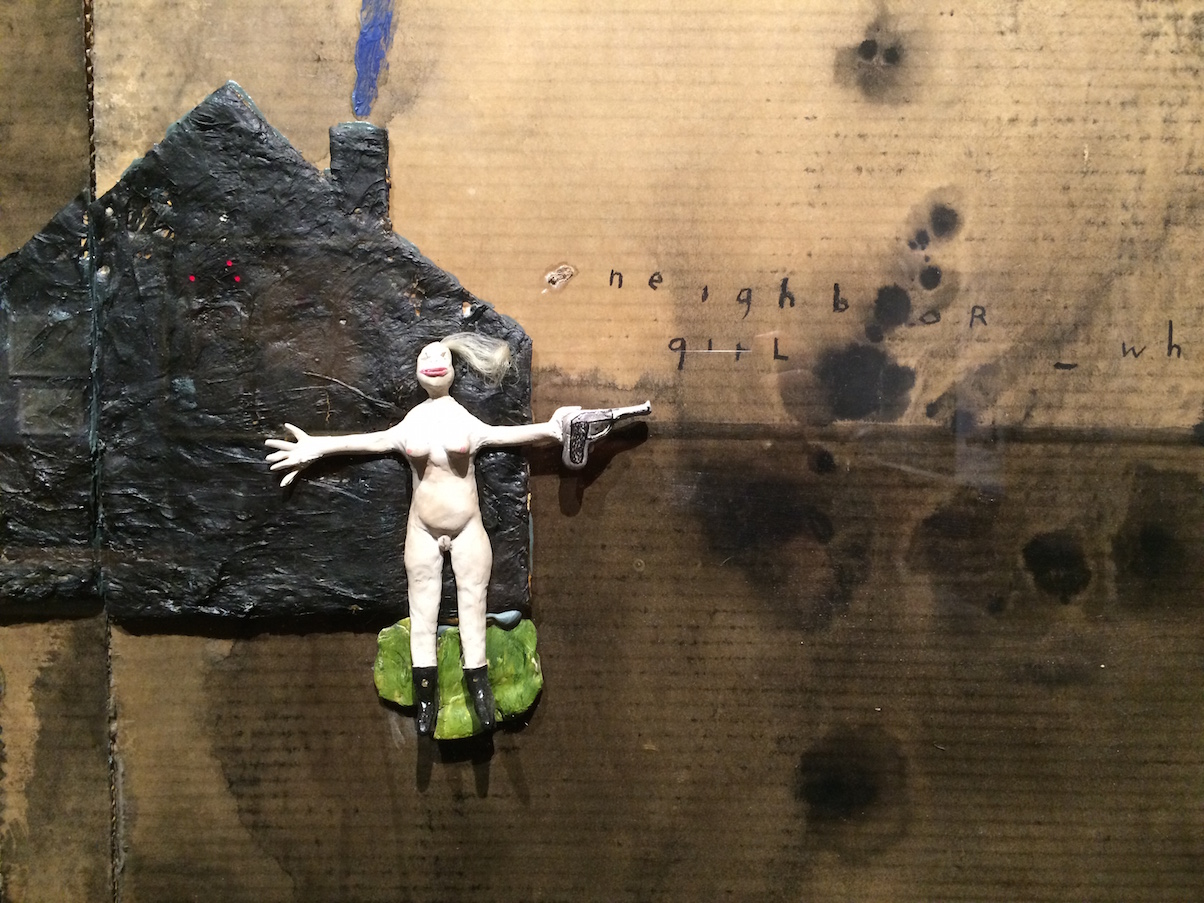Rachel Sitkin on the David Lynch exhibition at the Pennsylvania Academy of Fine Art
Yes, that David Lynch. David Lynch: The Unified Field is the oddball director’s first major exhibition of fine art in the U.S. Even if you are not a Lynch connoisseur (I must confess that I am not, though I have been inspired to watch and rewatch some of his films this past week) his name surely brings to mind images of a young Kyle McLachlan, a maniacal Dennis Hopper, or the deathly blue face of Laura Palmer.
Known for his darkly surreal art house films Eraserhead, Blue Velvet, Lost Highway, and Mulholland Drive and the early 90’s quirky TV thriller and cult classic, Twin Peaks, Lynch has continued to make fine art through out his career. This exhibition, currently on view at the Pennsylvania Academy of Fine Arts in Philadelphia, brings together over 90 of Lynch’s paintings, drawings, prints, and a small selection of minor films created over the last 50 years.
The first third of the exhibition is comprised primarily of paintings and drawings Lynch created in the late 1960’s – early 1970’s during his three semesters at PAFA, or in the years following while he still lived in Philadelphia. Even as a young artist, Lynch was already exploring many of the themes he continues to work with today: bodily illness, dysfunction and sickness, voyeurism, domestic violence, organic decay, and dark comedy.
Several large paintings depicting distressed figures emerging from flat black backgrounds reveal Lynch’s clear affinity for the work of British painter Francis Bacon.



The selection of sketches and more realized drawings from this period aren’t as imitative and show Lynch’s early investigation of surrealism and naïveté. A series of graphite drawings, possibly studies for Six Men… are especially energetic and graceful.
Also on view is a restaging of his first student film, Six Men Getting Sick (YouTube video). The short animated film loop is projected onto a wall featuring three fiberglass busts sculpted in high relief. It depicts 6 men, their stomachs filling up with a shocking red liquid, vomiting and finally being engulfed in flames as a piercing siren wails. Lynch credits this project as altering the course of his work.
Lynch’s later works are more cinematic and demonstrate his developed sense of composition and narrative, yet the surface treatment is often crude and at times brutish. A number of large mixed media paintings utilize all manner of materials and application techniques to violate the surface nearly to the point of destruction.
In A Figure Witnessing The Orchestration of Time, 1990 (image at top), Lynch depicts a highly distorted figure next to a smoldering fire. In addition to the sculptural treatment of the paint, a section of wire fencing protrudes from the painting and a puddle of shiny goo harbors a swarm of real bees. A limb fashioned from cotton extends through the fence and “menacingly” reaches over the heads of viewers.
Of the work from this period Lynch said, “All my paintings are organic, violent comedies. They have to be violently done and primitive and crude, and to achieve that I try to let nature paint more than I paint… In fact I don’t paint with a brush much anymore- I prefer to use my fingers.”
As Lynch developed as a filmmaker, his paintings and drawings became the raw material. Many of the later works in The Unified Field read like quick thematic studies; there are many charcoal drawings and black monotypes of airplanes, simply rendered figures and household objects. The graceful treatment of figures Lynch exhibited in his early work has been completely forgone in the paintings he’s made over this last decade. Yet it’s this crude treatment that keeps the work comedic. They are too childishly executed to be sincerely disturbing. His rudimentary use of the images and experience of childhood add silliness to the work that would otherwise be purely ominous.
In a series of monumental works created in 2009-10, Lynch depicts children lurking in the front yards of houses, threatening to burn or shoot the inhabitants.



In each of these paintings, executed on joined sheets of cardboard, electric lights illuminate the frames and the exaggerated figures each grasping their three-dimensional weapons appear on the brink of motion. They could be stills from an R rated version of Pee-Wee’s playhouse.

Possibly the most compelling piece in the show is Rock With Seven Eyes, 1996, in which a large lumpy mass of black paint swells from the center of an ocher canvas. Seven life-like glass eyes open from the rock to stare wildly at the viewer. Less self-conscious than in many of the other works in the show, this piece invites the viewer to fully embrace its absurdity.

Though Lynch’s fine art as a whole is not as intriguing as his films, this exhibit is fascinating as a companion to his larger cinematic ventures. His simple depictions of the images and themes that appear in the movies invite us to watch the films again, to reconsider the humor that we may have overlooked the first time.
As I rewatched Blue Velvet this week, a scene between Kyle McLachlan’s Jeffery Beaumont and Laura Dern’s Sandy Williams struck me. Jeffery is about to sneak into Dorothy Vallens’ apartment for the first time and Sandy says to him, “I don’t know whether you are a detective or a pervert.” With a straight face Jeffery replies, “Well that’s for me to know and you to find out.” I think this exchange concisely sums up the conversation Lynch is always having with his audience through his work, regardless of whether it is film or fine art. Maybe we’ll never find out?
David Lynch: The Unified Field is on view at the Pennsylvania Academy of Fine Art through January 11, 2015.
Author Rachel Sitkin is an artist, writer, and curator. She recently relocated from Baltimore to Philadelphia, PA.







